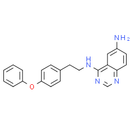Description
EVP4593, also known as QNZ and CAY10470, is an inhibitor of NF-κB activation with an IC50 of 11 nM in human Jurkat cells. EVP4593 reduced the number of lysosomes/autophagosomes and SOC currents in HD GMSLNs and exerted neuroprotective effects during cell aging. EVP4593 may be a promising anti-HD drug.
Product information
CAS Number: 545380-34-5
Molecular Weight: 356.42
Formula: C22H20N4O
Synonym:
EVP4593
EVP 4593
EVP-4593
Chemical Name: N4-[2-(4-phenoxyphenyl)ethyl]quinazoline-4,6-diamine
Smiles: NC1=CC2=C(NCCC3C=CC(=CC=3)OC3C=CC=CC=3)N=CN=C2C=C1
InChiKey: IBAKVEUZKHOWNG-UHFFFAOYSA-N
InChi: InChI=1S/C22H20N4O/c23-17-8-11-21-20(14-17)22(26-15-25-21)24-13-12-16-6-9-19(10-7-16)27-18-4-2-1-3-5-18/h1-11,14-15H,12-13,23H2,(H,24,25,26)
Technical Data
Appearance: Solid Power
Purity: ≥98% (or refer to the Certificate of Analysis)
Solubility: Soluble in DMSO
Shipping Condition: Shipped under ambient temperature as non-hazardous chemical or refer to Certificate of Analysis
Storage Condition: Dry, dark and -20 oC for 1 year or refer to the Certificate of Analysis.
Shelf Life: ≥12 months if stored properly.
Stock Solution Storage: 0 - 4 oC for 1 month or refer to the Certificate of Analysis.
Drug Formulation: To be determined
HS Tariff Code: 382200
How to use
In Vitro:
The aim of this study was to investigate whether QNZ mediates oxidative stress and inflammation contributed to IL-1β-induced nucleus pulposus (NP) cells degeneration in vitro. NP were isolated cells from human disc samples collected from patients and the IL1β-induced NP cells degenerated model was constructed. The cells were randomly divided into 3 groups, namely, Control group, IL1β group (10 µM), QNZ + IL-1β group (containing 10 nM QNZ and 10 µM IL-1β). This study showed that IL-1β promoted the progress of IDD, with markedly increased expressions of collagen I, p16, p53, and β-gal, as well as decreased expressions of collagen II and aggrecan. However, QNZ treatment could reverse the effects of IL-1β. It was found that cell proliferation was increased, ROS level was decreased, antioxidant enzymes were upregulated, and inflammatory factors were reduced after QNZ stimulation. Moreover, NF-κB/MAPKs signaling proteins IKKβ, IκBα, p65, ERK, JNK, and p38 were significantly dephosphorylated by QNZ. These results indicated that QNZ prevented NP degradation via restraining oxidative stress and inflammation through inhibition of the NFκB/MAPKs signaling pathway. QNZ may become a novel insight into the therapy of IVDD in the future.
In Vivo:
To further evaluate potential neuroprotective effects of EVP4593, it was tested in vivo with YAC128 mice and WT controls. an osmotic minipump loaded with 200 μl of EVP4593 (0.25 mg/ml) was used to infuse EVP4593 into the ventricles of 10.5-month-old WT and YAC128 mice over 6 weeks. the MSN spine density in EVP4593-treated WT mice was 13.04 ± 0.57 spines/10 μm (n = 32 neurons from 3 mice), significantly lower than in vehicle-treated WT mice (p = 0.0007; Fig. 11D). Also consistent with Figures 9 and 11, nSOC inhibition restored the YAC128 MSN spine density to WT levels (Fig. 11C). The spine density in EVP4593-treated YAC128 mice was 14.64 ± 0.57 spines/10 μm (n = 36 neurons from 6 mice). These data support an important role for nSOC in MSN spine maintenance and suggest that supranomal nSOC leads to spine destabilization in YAC128 MSNs in vivo. It has been demonstrated that EVP4593 reduces synaptic nSOC and rescues spine loss in YAC128 MSNs. Intraventricular delivery of EVP4593 in YAC128 mice rescued age-dependent striatal spine loss in vivo. The results suggest EVP4593 and other inhibitors of the STIM2dependent nSOC pathway as promising leads for HD (Huntington’s disease) therapeutic development.
References:
- Nekrasov ED, Vigont VA, Klyushnikov SA, Lebedeva OS, Vassina EM, Bogomazova AN, Chestkov IV, Semashko TA, Kiseleva E, Suldina LA, Bobrovsky PA, Zimina OA, Ryazantseva MA, Skopin AY, Illarioshkin SN, Kaznacheyeva EV, Lagarkova MA, Kiselev SL. Manifestation of Huntington's disease pathology in human induced pluripotent stem cell-derived neurons. Mol Neurodegener. 2016 Apr 14;11:27.
- Vigont V, Kolobkova Y, Skopin A, Zimina O, Zenin V, Glushankova L, Kaznacheyeva E. Both Orai1 and TRPC1 are Involved in Excessive Store-Operated Calcium Entry in Striatal Neurons Expressing Mutant Huntingtin Exon 1. Front Physiol. 2015 Nov 24;6:337.
Products are for research use only. Not for human use.
Payment & Security
Your payment information is processed securely. We do not store credit card details nor have access to your credit card information.


